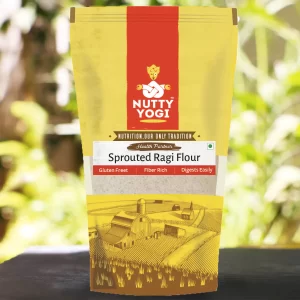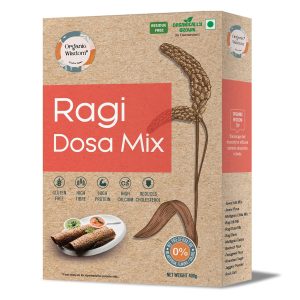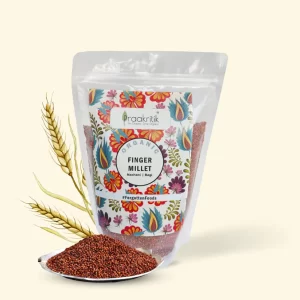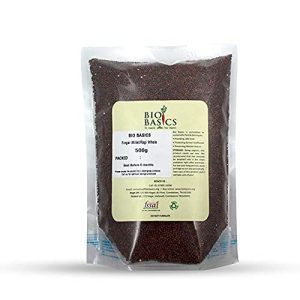What is Ragi?
Ragi is a highly nutritious cereal grain prominent in African and Asian countries, predominantly in India. ‘Ragi’ itself is the Indian name of finger millet and scientifically it is known as Eleusine coracana.
Ragi is a popular and well-liked food grain for having a bunch of health benefits; it is rich in essential vitamins and minerals like calcium, iron, and fiber. It is primarily planted in tropical regions such as Asia and Africa.
Ragi is a staple in many breakfast preparations. Ragi flour is used as a substitute for regular wheat flour. Apart from the ragi roti, we can use it in several other cuisines. Not for the taste, but ragi is famous for its many health benefits. Here in our blog, find more about ragi- its benefits, nutritional values, usage, and side effects!
Ragi Nutritional Facts
Ragi is a nutritional powerhouse of every important vitamin and mineral needed for human health. Ragi contains high concentrations of essential minerals like calcium, iron, protein, dietary fiber, and carbohydrates. The table below provides information on the nutritional value of ragi per 100g:
| Nutritional Components | Nutritional Value per 100g |
| Energy | 320 Kcal |
| Protein | 7g |
| Carbohydrates | 67g |
| Dietary fibre | 11g |
| Iron | 4.62 mg |
| Calcium | 364 mg |
15 Health Benefits of Ragi and Ragi Atta
Ragi or finger millet is a highly nutritious, gluten-free grain that boosts bone health, makes better digestion, controls diabetes, and many more. Here is a list of 15 ragi benefits:
Ragi has your daily dose of protein.
Are you looking for a grain that will provide your daily dose of protein? The answer is ragi, also referred to as common finger millet. One of ragi’s key benefits is its high protein content, which accounts for this. It’s a great, high-nutrient source of protein for vegans.
Ragi is a weight loss friend.
Ragi’s high fiber content contributes to the meal’s long-lasting fullness. Ragi is an excellent option for anyone attempting to reduce their calorie intake and minimize the emotional swings brought on by hunger. It is a great tool for a healthy weight loss journey.
Reduces blood sugar level
Ragi aids in blood sugar regulation because it has a low glycemic index. It gradually resists glucose from entering the bloodstream. Ragi is an excellent grain for diabetics since it stops sudden blood sugar spikes that occur right after meals.
Prevents skin injury
Ragi contains methionine, an amino acid that keeps skin smooth and keeps it from drooping. Ragi is a fantastic source for anti-aging skincare regimens because it helps to renew the skin and minimize the appearance of fine lines and wrinkles.
High in Fibre
The high digestible fiber level of ragi helps to maintain overall gut health and prevent constipation, which is beneficial to the digestive tract. Because it helps to control blood sugar levels, ragi is highly beneficial for diabetics.
Rich in Calcium
Ragi is a good source of calcium, which is essential for healthy bones. Regular use of ragi reduces the occurrence of osteoporosis and other disorders associated with the weakening of teeth and bones. This is especially advantageous for elderly people and growing children.
Improves digestive health
Ragi regulates bowel motions and keeps the digestive tract healthy by warding off constipation. The reason is, that ragi is packed with nutritional fiber. Ragi’s inherent laxative qualities enhance general digestive health and lower the risk of gastrointestinal problems. Also, this ragi helps to empty the digestive tract.
A gluten-free substitute
Ragi is an excellent grain for anyone with celiac disease or gluten intolerance because it is naturally gluten-free. It’s a nutritious replacement for wheat-based products, allowing those on a gluten-free diet to obtain several essential nutrients.
Gives an antioxidant boost
Ragi’s antioxidants and phenolic components help our body fight off damage from free radicals. This reduces the risk of chronic illnesses like cancer and heart disease, minimizes oxidative stress, and slows down the aging process.
Promotes a healthy heart
One of the main ingredients in ragi is magnesium. It lowers blood pressure and relaxes blood vessels. In addition to lowering cholesterol, ragi’s high fiber content lowers the risk of heart disease, hypertension, and stroke.
Helps in managing anemia
Ragi’s high iron content makes it a good diet choice for anemia. Frequent ingestion raises hemoglobin levels, which improves blood oxygen delivery and lessens anemia-related symptoms including fatigue and dizziness.
-
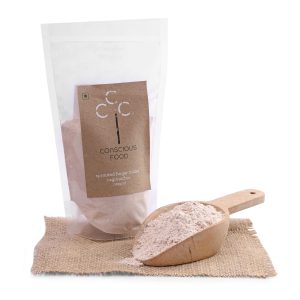 Conscious Food Sprouted Ragi Flour₹114 – ₹205 Shop Now
Conscious Food Sprouted Ragi Flour₹114 – ₹205 Shop Now -
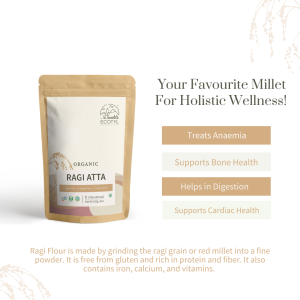 Ecotyl Organic Ragi Atta (Finger Millet Flour) – 250 g₹14026% OFF Shop Now
Ecotyl Organic Ragi Atta (Finger Millet Flour) – 250 g₹14026% OFF Shop Now
Promotes Oral Health
Ragi’s high calcium and phosphorus concentration helps in having healthy gums and strong teeth. You can include ragi in your platter and consume it regularly. Ragi strengthens the enamel and guards against gum disease and tooth decay. Also, promotes long-term dental health.
Keeps check on cholesterol levels
Ragi can cause a decrease in cholesterol levels because it includes essential amino acids like methionine and lecithin. These two can help the liver to eliminate excess fat. Regi’s high fiber content decreases bad cholesterol (LDL), supports heart health, and reduces the risk of cardiovascular diseases.
Improves Liver Health
Ragi reduces the total amount of fat that accumulates in the liver, which enhances liver function. Its important amino acids and high fiber content assist in detoxifying the liver, promote liver health and function, and protect the liver against conditions like fatty liver disease.
Improves Eye Health
Ragi is rich in naturally containing antioxidants, such as vitamin A, which is essential for maintaining a healthy vision. Regular consumption of ragi can help preserve long-term eye health by reducing the likelihood of age-related eye diseases such as macular degeneration and cataracts.
Ragi benefits for skin and hair.
Ragi is high in vitamins, minerals, and amino acids – all of which are essential for healthy skin. Its antioxidants keep our skin younger and healthy by scavenging free radicals. It also helps to reduce UV-ray damage and pigmentation.
For hair, Ragi’s high protein content helps in healthy hair management. It stops hair loss and strengthens the hair roots from the core. The iron in ragi improves blood flow and gives the scalp the nutrition it needs to keep hair healthy.
All the nutrients present in ragi keep the skin and scalp hydrated and nourished. That’s why we would like to recommend you to have ragi every day to get glossier and smoother skin and hair.
Benefits of ragi for women
Ragi boasts several health benefits for general human health. But apart from that, ragi is a very good option, especially for women. Here is why:
Supports weight management
Due to its high fiber content, ragi helps women to feel fuller for longer periods, which reduces appetite and encourages control over weight. It is an ideal food for ladies who want to maintain steady blood sugar levels without experiencing sudden surges because of its slowly digesting carbs.
Boosts bone health
Ragi is a great source of calcium for strong bones, especially for women who may be at risk for osteoporosis. Regular ragi consumption enhances bone density and overall skeletal strength while supporting women’s health during menopause, a period when bone loss is typical.
Helps manage menopause symptoms
Ragi, which is high in calcium and phytoestrogens, helps with hot flashes, mood swings, and bone loss, among other menopausal symptoms. Its nutrients help to prevent osteoporosis, a disease that can occur in postmenopausal women. Ragi is also a good food option to promote hormonal balance.
Promotes healthy pregnancy
Ragi is a great source of iron, calcium, and fiber – all the nutrients that are essential for pregnant women. It supports good fetal growth, strong bones, and the avoidance of anemia, a common concern during pregnancy due to increased blood volume.
Good for lactating women
Ragi’s high nutritional content can help in nursing babies by increasing milk production in lactating mothers. Ragi’s high calcium and iron content helps to ensure optimal health for both mother and child by promoting healthy lactation and replenishing minerals lost during breastfeeding.
Supports hormonal balance
Ragi’s high fiber content aids in hormone regulation for women. It is a friend to those who suffer from PCOS (polycystic ovarian syndrome). It supports regular menstrual cycles and lowers insulin resistance, which improves reproductive health in general.
Ragi Uses For Skin And Hair
Ragi is high in nutrients that are beneficial to the skin and hair. Here, in our blog, we have already mentioned that ragi helps in several ways to get healthy hair and skin. Ragi is high in antioxidants and amino acids and these prevent premature aging and minimizes fine lines and wrinkles.
Ragi’s high vitamin B content strengthens hair follicles and promotes hair growth, preventing hair loss. Ragi flour can be used in face masks to give skin a smooth, natural glow by eliminating dead skin cells. Additionally, the calcium and iron in ragi helps to improve blood circulation, which nourishes the scalp and skin. Ragi-based hair masks will give you stronger, glossier hair and improved skin. Here are some ways to use Ragi externally:
- Face Mask: Mix ragi flour with yogurt and honey to make a natural face mask. Apply on your skin for 15-20 minutes and wash it off.
- Ragi Body Scrub: Make a handmade body scrub. Mix milk or water with ragi flour, and make a thick paste. Scrub this on your body to remove dead skin cells.
- Hair Mask with Ragi: Make an oil-paste to apply on hair. Mix coconut oil and ragi flour well. Apply it on your hair. Keep it for 15 to 20 minutes. Rinse with shampoo.
Healthy and Tasty Ragi Recipes
Here are a few healthy and tasty ragi recipes:
Ragi Dosa
Ingredients to cook
- 1 cup ragi flour
- ½ cup urad dal
- ¼ cup rice
- Salt
- Water
- Oil
Process to follow
Soak urad dal and rice flour overnight. Next morning, grind them all to make a thick batter and mix ragi flour. Keep it for fermentation. Now add salt and check. Heat the pan and make dosas.
Ragi Porridge
Ingredients to cook
- 2 tbsp ragi flour
- 1 cup milk or water
- 1-2 tbsp jaggery
- A pinch of cardamom powder
Process to follow
Warm the milk or water and then add ragi flour to it. Cook this mixture for 5 to 7 minutes. It will become thick. Then add jaggery powder and cardamom powder. Cool it down and serve.
Ragi Ladoo
Ingredients to cook
- 1 cup ragi flour
- ½ cup jaggery
- 2 tbsp ghee
- ¼ cup mixed nuts (optional)
- ½ tsp cardamom powder
Process to follow
Roast the dry fruits in ghee and crush them roughly. Keep this aside. Now heat the pan and dry roast the ragi flour, add jaggery powder and crushed dry fruits. Shape like ladoos and enjoy.
Ragi Idli
Ingredients to cook
- 1 cup ragi flour
- 1 cup rice
- ½ cup urad dal
- Salt to taste
Process to follow
Soak the urad dal, rice and ragi flour overnight. Grind them and mix ragi flour with it. Now make the idlis in an idli-shaped pan. Steam them for 10-15 minutes.
Side Effects of Ragi
Although ragi has many health advantages, at the same time it possesses some side effects too. Ragi is not suggested to those who are prone to kidney problems because this little grain contains a good amount of oxalic acid. It can worsen the condition of kidney stones.
Ragi contains a lot of fiber, thus consuming too much of it may result in gastrointestinal issues like bloating and gas. One other component, Phytotates, is found in ragi. It has the power to prevent the absorption of calcium and other minerals. Ragi has several health advantages when consumed in moderation, including lowering the risk of illness and encouraging relaxation. Ragi is a 100% useful food if it is consumed as a part of a balanced diet.
Conclusion
Ragi is an excellent addition to any diet due to its many health benefits. We have covered ragi benefits well in this blog, with extra stress on women-centric benefits. Ragi contains several health advantages, such as a high nutritional content and other advantageous characteristics. This superfood can be used in a wide variety of cuisines, such as ragi laddoos, ragi dosa, and ragi porridge (some ragi recipes are also provided here for your help). Apart from all of that, if you want to buy healthy ragi products or raw ragi, Orgo All-Natural is there for you!
References
- International Journal of Home Science – Finger millet (Ragi) as an essential dietary supplement with key health benefits
- Researchgate – Finger Millet (Ragi, Eleusine coracana L.). A Review of Its Nutritional Properties, Processing, and Plausible Health Benefits
- The Journal of Phytopharmacology – Functional properties and health benefits of finger millet












